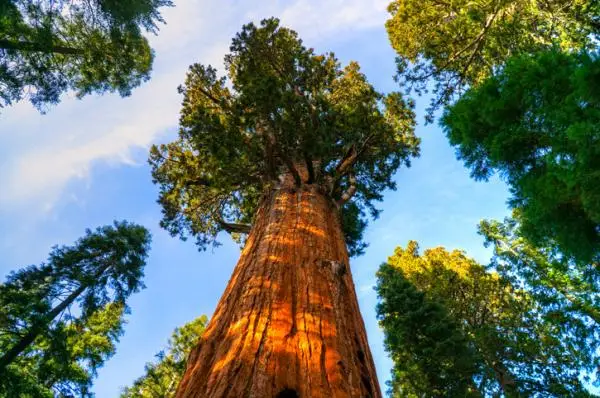When we look at a large tree, it is inevitable that we feel a sense of solemn respect, and it is that observing those great colossi that have been there for centuries provides a perspective vision, which sometimes we really need. In the world, few are trees that can equal in size to the giant sequoia ( Sequoiadendron giganteum ), also known as the giants of the forest. The giant sequoia is not the tallest tree on the planet (it is a redwood or Sequoia sempervirens, which is also a more common species than the giant), but it is considered the largest non-colonial organism in the world.
If you want to learn some things about these natural giants, keep reading us in this article in which you will discover the characteristics of the giant sequoias and where they are. In addition, you will be able to see a photo gallery of giant sequoias.
Giant sequoia characteristics
The giant sequoia consists of a single species: the Sequoiadendron giganteum . This conifer reaches heights of up to 95 meters, with up to 11 meters in diameter. However, there are more redwoods, with the most common being the Sequoia sempervirens or redwood. With such dimensions, it is normal for anyone who loves nature who visits or contemplates a forest of giant sequoias to keep the memory for life, despite the fact that they are never found in forests comprised solely of these trees.
- The giant sequoia has a straight trunk of a reddish brown tone , completely free of branches during the first half of the trunk, from which the adult trees begin to emit branches, usually straight as well, ending in a rounded crown at the end. From the tree.
- Each individual produces both male and female cones or cones, containing more than 200 redwood seeds on average.
- Once the pineapple or cone dries, the wind carries the tiny winged seeds to their new location, where they will germinate if the conditions are right, which are mainly mineral soils and direct sunlight, without competition from other plant species.
- The thick bark of giant sequoia trees, with up to 60 cm of bark , is known to be an exceptional defense against fires, which is why these trees tend to be healthier in places where light fires are relatively common. , since they eliminate competition and provide nutrients to the soil, in addition to helping to open the cones and disperse the seeds due to the contribution of heat.

How long does a giant sequoia take to grow?
Redwoods are said to be slow-growing trees, although, as with all plants, this largely depends on the circumstances and environment in which they thrive. Giant sequoia trees take about 20 years to form a mature trunk and their first cones or cones, after which they continue to grow at a rate of between 2 and 5 cm per year. In a controlled crop, it is possible to speed up this growth a bit by supplying it with compost in the form of organic matter such as compost, although even so, the growth rate will not increase too much.
The seeds of giant sequoias , in addition, have it quite difficult to germinate and develop since, as we have mentioned before, they need to grow in full light and in mineral soils, without competition from other plants. It is because of this that they grow more in areas with the occasional mild fire, since competition is less. Thus, under the ideal conditions, the oldest known individuals exceed 3,000 years of age .
Where are the giant sequoias
Wondering where to see giant sequoias ? Here we indicate the main places to see them.
Giant sequoias in the US
Giant sequoias are found naturally only in a very specific area in the western Sierra Nevada, California, of less than 150 km². There is the park of giant sequoias in California , the Sequoia National Park , which was created in 1890. Unfortunately, having given priority in past times to tourism and commercialization around these trees caused disasters such as the fall of the Pionner Cabin tree or Tunnel tree, one of the largest and oldest specimens that fell in a storm due to the tunnel made at its base. Giant sequoias can also be seen in Yosemite National Park .
Giant sequoias in Spain
However, in Cantabria there is a forest of giant sequoias that were planted there at the beginning of the Second World War and which is, since 2003, a natural monument. Located in Cabezón de la Sal, the giant sequoia forest in Cantabria has 848 individuals, which have a height of about 40 meters.
Giant sequoias in Mexico
We also find giant sequoias in Mexico, specifically in Jilotepec, in Las Secuoyas park . The specimens there were brought from California, redwoods up to more than 100 feet tall.
General Sherman, one of the largest redwoods
The General Sherman tree is not the tallest sequoia in the world, but it is the largest sequoia in the world . It is, in fact, the living being with the highest amount of biomass on the entire planet. Although there are other taller trees, its large diameter of 11 meters and its height of 83.8 meters give it an enormous volume.
The General Sherman sequoia is found in the Sequoia National Park , and belongs to the species Sequoiadendron giganteum , that is, it is a giant sequoia.

Hyperion, the tallest redwood
The tallest tree in the world is Hyperion , a Sequoia sempervirens no less than 115.66 meters tall. This is found in Redwood National Park , also in California and north of San Francisco. Its specific location is kept secret to this day, in order to protect the specimen from the damage caused by the massive influx of tourism.
